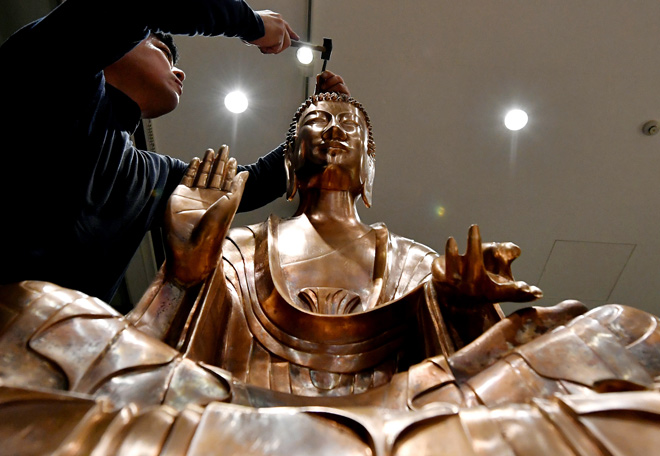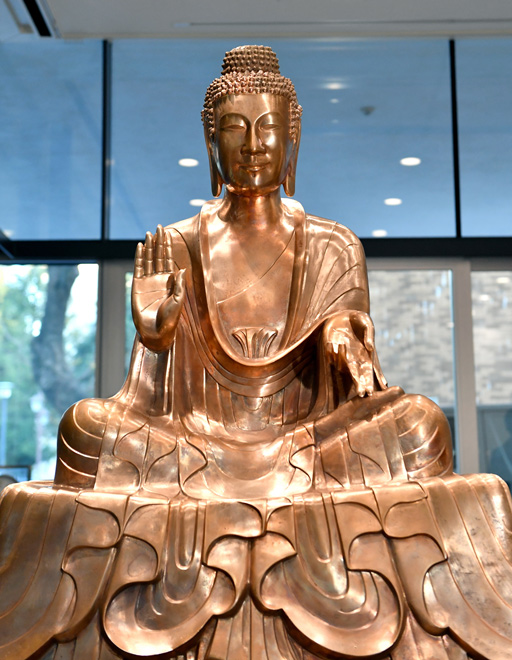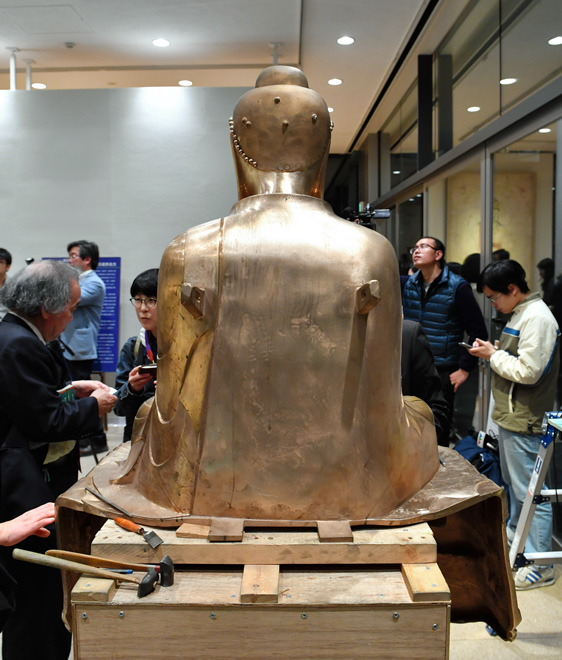Information
‘Cloned’ ancient sculptures show opens up new exhibition ideas
A reproduction team member puts the finishing touches to the Gautama Buddha statue replica at the Tokyo University of the Arts Ueno campus in Tokyo’s Taito Ward on Feb. 16. (Takuya Isayama)
Priceless seventh-century statues replicated using 3-D printing technology so accurately that they are described as “clones” were unveiled at the Tokyo University of the Arts campus in the capital’s Ueno district on Feb. 16.
The replicas of the “Shaka-sanzon-zo” Gautama triad statues, of Horyuji temple in Nara Prefecture, were presented by the joint council of Tokyo University of the Arts, and the city governments of Takaoka and Nanto of Toyama Prefecture.
The team of university researchers and traditional craftsmen, who created the clones using a combination of state-of-the-art and traditional techniques, say the objects open up possibilities of further exhibitions of precious and fragile cultural properties in the future.
“‘Cloning’ our cultural properties would allow us to stage exhibitions in new ways,” said Masaaki Miyasako, professor of cultural property conservation at the university.
“For example, the accompanying statues on either side of Gautama Buddha are said to have originally been placed on opposite sides. We could move them to the other side in a show--something we cannot do with original national treasures.”
As the triad--Gautama Buddha and two accompanying bodhisattvas--are government-designated national treasures, Horyuji temple, also a UNESCO World Heritage site, has never loaned them out for public exhibitions.
However, residents of Takaoka and beyond will have an opportunity to see the next best thing in March.
The statues were first replicated by the university team using high-definition 3-D scan data to create resin models with a 3-D printer.
Then, molds were made from the resin replicas, and a Takaoka-based team from a business cooperative association for promoting bronzeware cast replicas in gilt bronze, the same material as the originals.
The wooden base was produced by a team from Inami Wood Carving Cooperative, based in Nanto.
Tokyo University of the Arts Center of Innovation (COI) has been promoting reproductive technology using 3-D printers, as it can significantly reduce the time required to produce replicas, compared to making them from scratch.
Transporting a 3-D printed copy is relatively painless, and having replicas means they can be viewed from all sides, which may not be possible in the original versions’ usual settings.
“At the public display in Takaoka, the interior of Kondo hall (where the triad is kept) will be recreated, including the murals, and the visitors will be invited to touch the statues and murals to feel the presence of the statues directly,” said Miyasako.
The Gautama triad replicas will go on display from March 10 through March 20 at Wing Wing Takaoka, near JR Takaoka Station, Toyama Prefecture.
Category: English
News
Information
Key words:



